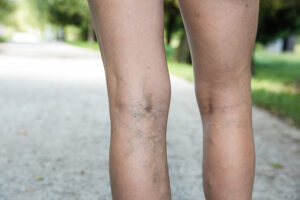What causes vein disease?

Vein disease is a very common problem, especially as people age. In fact, vein disease affects more than 30 million people in the United States. Why does vein disease happen to so many people? It’s partly because of how veins are constructed. Thin-walled structures are responsible for returning blood to the heart after it’s been depleted of oxygen, veins contain valves that keep blood flowing in one direction. When veins are damaged, it causes irregular blood circulation that allows blood to flow backward and collect in the veins. This can cause problems for veins in many different ways.
First, this backward flow of blood creates high pressure within the veins. This can damage veins, causing them to stretch, twist, and swell, which leads to further valve incompetence, slows the flow of blood, and can potentially cause blood clots to form. Let’s look at a few types of vein diseases and how they’re caused.
- Varicose veins affect about 15 percent of Americans. They’re not typically dangerous, but they are unsightly and can be uncomfortable. Twisted, swollen veins near the surface of the skin, varicose veins are typically the result of blood flowing backward or stagnating within the vein. In some cases, varicose veins can be caused by chronic obstruction, but this is not typical. Varicose veins occur in women twice as often as in men, and they usually appear in the legs. Hemorrhoids are also a type of varicose vein.
- Superficial Thrombophlebitis is usually the result of a blood clot in a vein. It’s called superficial thrombophlebitis because it occurs near the skin’s surface, and it’s a minor disorder. This condition generally doesn’t cause more than a red, tender vein.
- Deep vein thrombophlebitis is a more serious condition than superficial thrombophlebitis. This is because it affects larger veins that are further beneath the surface of the skin. At first, there may be less-pronounced symptoms, or it can even be asymptomatic. However, there’s a risk of a pulmonary embolism if the clot detaches and ends up in the lung. There’s also a risk of chronic venous insufficiency, which can cause varicose and spider veins, dermatitis, increased pigmentation of the skin, venous ulcers, and swelling.
- Blood clots are a big problem, no matter where they occur. They can develop in the veins when there’s a problem with either the normal flow of blood or with clotting. Blood clots can be the result of inflammation, can occur when veins are damaged due to surgery or trauma, or can happen because of a long period of inactivities, such as bed rest or prolonged sitting. Venous insufficiency, often caused by deep vein thrombosis, can raise the risk of blood clots.
Whether you have vein issues or an artery problem like atherosclerosis, you can get the very best treatment from the board-certified physicians at the Arizona Vein & Laser Institute. Using the most advanced technology, the vascular and cardiovascular surgeons at the Arizona Vein & Laser Institute provide care for all types of venous diseases. With over 40 years of experience, our team of experienced physicians can devise the right treatment plan to address your venous disease problems. For more information contact us through our website.
